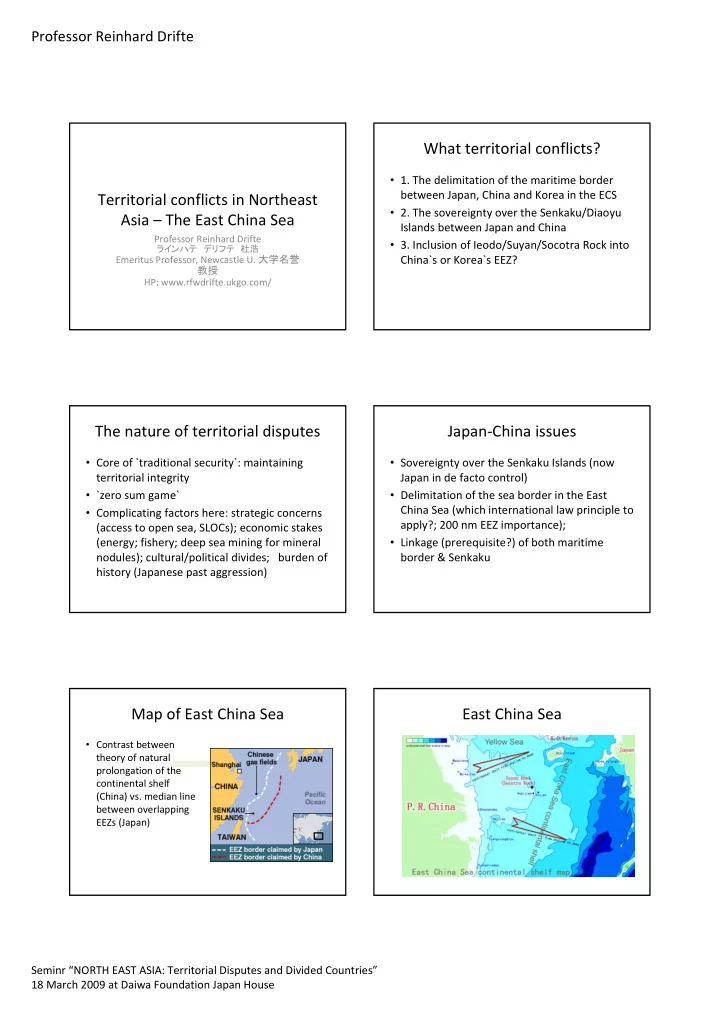

Professor Reinhard Drifte What territorial conflicts? • 1. The delimitation of the maritime border between Japan, China and Korea in the ECS Territorial conflicts in Northeast • 2. The sovereignty over the Senkaku/Diaoyu Asia – The East China Sea Islands between Japan and China Professor Reinhard Drifte • 3. Inclusion of Ieodo/Suyan/Socotra Rock into ラインハテ デリフテ 杜浩 Emeritus Professor, Newcastle U. 大学名誉 China`s or Korea`s EEZ? 教授 HP: www.rfwdrifte.ukgo.com/ The nature of territorial disputes Japan ‐ China issues • Core of `traditional security`: maintaining • Sovereignty over the Senkaku Islands (now territorial integrity Japan in de facto control) • `zero sum game` • Delimitation of the sea border in the East China Sea (which international law principle to • Complicating factors here: strategic concerns apply?; 200 nm EEZ importance); (access to open sea, SLOCs); economic stakes (energy; fishery; deep sea mining for mineral • Linkage (prerequisite?) of both maritime nodules); cultural/political divides; burden of border & Senkaku history (Japanese past aggression) Map of East China Sea East China Sea • Contrast between theory of natural TROUBLED W ATERS prolongation of the continental shelf (China) vs. median line between overlapping EEZs (Japan) Seminr “NORTH EAST ASIA: Territorial Disputes and Divided Countries” 18 March 2009 at Daiwa Foundation Japan House
Professor Reinhard Drifte Japan ‐ China: Main points Japan ‐ China: Where are we now? China`s late claim to Senkaku in 1970 (1895 ‐ 1970 gap!) 18 June 2008 agreement on cooperation in the ECS as a commitment to negotiate • • a Treaty (agreement on principles): 1980s: China`s begin of exploration + exploitation in the ECS • ‐ joint development in a clearly defined area as a first step (Northern part of ECS) + • 1996 both sign UN CLOS • commitment to consult about other areas outside of the above area for joint Japan`s misleading signals: `shelving` of Senkaku issue 1972, 1979; Japan`s • development abstention from even exploration until 2004; 1997 ‐ 2001 JBIC/ADB co ‐ ‐ participation of Japanese legal persons in the development of the Chunxiao oil • financing of China`s Pinghu field (70 km off median line) and gas field in accordance with Chinese laws 2001 Prior Notification Agreement; 1997 Fisheries Agreement (`joint ‐ the agreement indicates implicit Chinese acknowledgment of the median line • • because the defined zone for joint development approximately straddles this line fishing areas`) and differentiates between Chunxiao and the joint development zone From 1998 ‘Consultations on the Law of the Sea and the Delimitation of • Concern about military clashes (increased presence of Chinese warships/fighters; • the EEZ’ 2004 harassment of Japanese exploration) From 2004 to 2008 ‘Japan ‐ China Consultations concerning the East China • Dec 08: J reports continued Chinese exploration in the Tianwaitian gas field (50–60 • Sea and Other Matters’ km from the median line, started in September 2005!) Not even begin of negotiations despite Japanese reminders! • Tianwa itian oil platform Japan ‐ China ‐ ROK issues • 21 September 2005: • Link to Japanese occupation before 1945 (Dokto/Takeshima 1910; Senkaku/Diaoyu Jan 1895 just before end of Sino ‐ Start of extracting gas? Japanese war) • January 2008 Japanese • No ECS maritime border agreed between J ‐ ROK, ROK ‐ China protests about China`s • Overlap of J ‐ ROK ‐ China EEZ claims at Northern end of ECS continuing extraction • 1974 Japan ‐ South Korea treaty (1978 J ratification; Chinese protests, 1980 ‐ 86 J ‐ ROK fruitless explorations) • Japan accepted SK`s extended continental shelf approach! • 1997 Japan ‐ China Fisheries Agreement: Korea claims overlap of EEZs; demands trilateral negotiations China ‐ Korea: Ieodo/Suyan Rock Iedo/Suyan Rock • 82 nm southwest of Jejudo; 147 nm miles northeast of China • In 1900 discovered by the British merchant ship `Socotra`, 1951 claimed by Korea • surface area of 370,000 sq m. at the depth of 50 meters, highest point on the rock is 4.6 meters below sea level • Korean weather station • China: rock is within China`s 200 nm EEZ! • 2000: China and ROK agree that it is a submerged rock, NOT an island, therefore no sovereignty issue, only EEZ issue Seminr “NORTH EAST ASIA: Territorial Disputes and Divided Countries” 18 March 2009 at Daiwa Foundation Japan House
Professor Reinhard Drifte China ‐ Korea: Maritime border Solutions • Liberalist theory: `shared economic interests lead to • No agreement cooperation`? • Realist theory: `balance of power`; `anarchic international society, maximizing one`s own interest` • Last negotiations: • International Law: arbitration of conflicting interests based on a common cannon of rules, but subject to political influence in the absence of international court intervention July 2008 (13 th • None of the 3 countries accepts international arbitration for any of the sovereignty or EEZ delimitation issues round) Relevant publications by the author: • R. Drifte, `Japanese – Chinese territorial disputes in the East China Sea – between military confrontation and economic cooperation`, LSE Asia Research Centre Working Paper no. 24, April 2008, http://www.lse.ac.uk/collections/asiaResearchCentre/ pdf/WorkingPaper/ARCWorkingPaper24Drifte2008.pdf • R. Drifte, The 18 June 2008 Agreement, http://www.giga ‐ hamburg.de/dl/download.php?d=/content/publikation en/archiv/ja_aktuell/jaa_0803_fokus_drifte.pdf (space= lower hyphen!) Seminr “NORTH EAST ASIA: Territorial Disputes and Divided Countries” 18 March 2009 at Daiwa Foundation Japan House
Recommend
More recommend